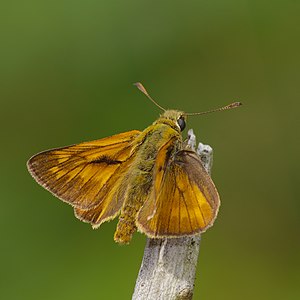Rust-colored thick-headed butterfly
| Rust-colored thick-headed butterfly | ||||||||||||
|---|---|---|---|---|---|---|---|---|---|---|---|---|

Rust-colored thick-headed butterfly ( Ochlodes sylvanus ) ♂ |
||||||||||||
| Systematics | ||||||||||||
|
||||||||||||
| Scientific name | ||||||||||||
| Ochlodes sylvanus | ||||||||||||
| ( Esper , 1778) |
The rust-colored thick-headed butterfly ( Ochlodes sylvanus , syn .: Augiades sylvanus ) is a butterfly (day butterfly ) from the family of the thick-headed butterfly (Hesperiidae). The specific epithet is derived from Silvanus , a forest god from Roman mythology .
description
The moths reach a wingspan of 25 to 32 millimeters. The wings of the rust-colored thick-headed butterfly are, as the name suggests, rust-brown in color. The hind wing undersides are more or less greenish and show indistinct yellow spots. The males are characterized by an elongated black scented scented spot on the upper side of the forewing ( sexual dichroism ).
The caterpillars are about 28 millimeters long. They are light green in color and have a slightly darker back line. The head is dark brown and has slightly lighter, broad lines on the sides.
Synonyms
The following synonyms exist:
- Augiades sylvanus Esper
- Ochlodes venata ( Bremer & Gray , 1853)
- Ochlodes venatus ( Bremer & Gray , 1853)
- Ochlodes melicerta Bergsträsser , 1780
- Ochlodes faunus ( Turati , 1905)
- Pamphila sylvanus Esper
Similar species
- Hesperia comma ( Hesperia comma ) (Hesperiidae)
Flight time
The moths fly in one generation from May to July and August. In Spain , two generations are said to occur from May to August.
Way of life
After mating, the females lay the hemispherical, flat, cream-colored eggs individually on the underside of the leaves of the host plants. The caterpillars pull individual grass leaves together with fine threads into a tube and feed in them. The half-grown caterpillars overwinter in the woven grass (a so-called "overwintering bag") and continue to eat in spring until the end of May. Pupation takes place in a silk cocoon from which the moths hatch after about three weeks. The nectar plants of the moths include Handelwurzen ( Gymnadenia ), bird vetch ( Vicia cracca ), scratch thistles ( Cirsium ), pigeon scabies ( Scabiosa columbaria ), Knautia and blackberries .
Food of the caterpillars
The caterpillars feed on common ballgrass ( Dactylis glomerata ), whistle grass ( Molinia caerulea ), pinnate twinkle ( Brachypodium pinnatum ), sand saddle grass ( Calamagrostis epigejos ), meadow bluegrass ( Poa pratensis ), reed fescue ( Festuca ) arund -Hainsimse ( Luzula pilosa ), Woolly honey grass ( Holcus lanatus ), Common couch grass ( Agropyron repens ), Flatter bulrush ( Juncus effusus ), redtop ( Agrostis capillaris ), timothy grass ( Phleum pratense ) and upright brome ( Bromus erectus ) .
habitat
The rust-barbed thick-headed butterflies live in near-natural moist and dry biotopes. This includes both open land (meadows, roadsides, fallow land, tall herbaceous meadows) and transition areas to the forest. In the Wildenburger Land, flower visits were observed on field and swamp thistle ( Cirsium arvense and C. palustre ) and blackberries ( Rubus fruticosus ). Important nectar plants of the moth, as in most other European butterflies are found especially among the labiates ( Common Wirbeldost , German Ziest , Ross-mint , meadow sage , oregano or True Betonie ) and the Asteraceae .
distribution
The species is widespread and common in Europe. However, it does not occur in North Africa , Ireland , on the Mediterranean islands (except Sicily and Corfu ). The northern limit of distribution is around 64 ° N. Ochlodes sylvanus is absent in northern Scandinavia and in the north of the British Isles.
swell
Individual evidence
- ^ Arnold Spuler: The butterflies of Europe . tape 1 . E. Schweitzerbartsche Verlagbuchhandlung, Stuttgart 1908, p. 73 .
- ↑ Lepiforum eV - Ochlodes sylvanus / Taxonomic Notes Accessed July 11, 2006
- ↑ Tom Tolman, Richard Lewington: The butterflies of Europe and Northwest Africa , Franckh-Kosmos Verlags-GmbH & Co, Stuttgart 1998, ISBN 3-440-07573-7
- ↑ Ralph Schöpwinkel, 2005: Development of a model and a development plan for meadow valleys in Wildenburger Land with butterflies as bioindicators , dissertation University of Bonn, Faculty of Mathematics and Natural Sciences, p. 99 PDF ( Memento of the original from July 14, 2014 in the Internet Archive ) Info: The archive link was inserted automatically and has not yet been checked. Please check the original and archive link according to the instructions and then remove this notice. (as Ochlodes venata )
- ↑ Butterflies - caterpillars - forage plants. Special edition Berner Vogelschutz BVS, p. 16 PDF ( page can no longer be accessed , search in web archives ) Info: The link was automatically marked as defective. Please check the link according to the instructions and then remove this notice.
literature
- Hans-Josef Weidemann: Butterfly: observe, determine , Naturbuch-Verlag Augsburg 1995, ISBN 3-89440-115-X
- Günter Ebert (Hrsg.): The butterflies of Baden-Württemberg Volume 2, Tagfalter II (Augenfalter (Satyridae), Bläulinge (Lycaenidae), Dickkopfalter (Hesperiidae)), Ulmer Verlag Stuttgart 1993. ISBN 3-8001-3459-4
Web links
- www.schmetterling-raupe.de
- www.eurobutterflies.com (English)
- www.insektenbox.de
- Moths and Butterflies of Europe and North Africa (English)
- Ochlodes sylvanus at Fauna Europaea



